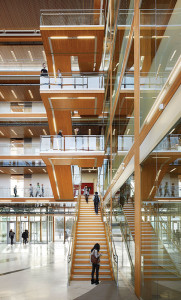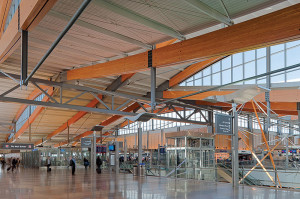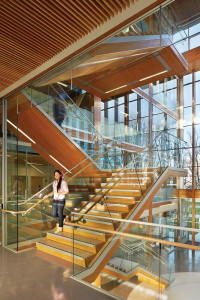Until the middle of the 19th Century, wood was commonly used as a primary structural building material in many types of non-residential buildings around the world. Many of these timber-built structures remain standing and are still in use today, including factories, warehouses, schools, temples, and churches – some dating as far back as the seventh century. Famous examples include the 106.6-foot (32.5 meter) high Horyu-ji Temple in Nara, Japan, which demonstrates the durability and strength of building with wood.
With the industrial revolution came significant evolution in steel and concrete technology, and these materials, popularized by construction of revolutionary projects such as the Eiffel Tower and new “skyscrapers” in America, took over as materials of choice for large and important projects.
As a result, timber has more or less been relegated for use as a material for smaller structures. And with the development of efficient and versatile light wood-frame construction monopolizing the low-rise residential market in North America, wood initially all but lost large portions of the non-residential construction market to steel and concrete.
Over the past two or three decades, however, timber engineering and construction has experienced significant and transformative advances, setting wood products up for a comeback. These include new engineered wood products, including solid panel products such as cross-laminated timber (CLT), computer numerically controlled (CNC) fabrication, versatile high-efficiency timber connectors, and progress in fire protection engineering. With technical progress and increased demand for wood products comes greater economic opportunities.
Today the most ancient construction material, and the only one that is naturally grown by the sun, is becoming more high-tech and still has considerable development potential in store.
This technical progress seems to have combined with other positive influences to reposition wood on the world stage. A renewed interest in timber as an architectural medium, combined with strong trends in sustainability, is promoting the expanded use of wood in several countries including Canada, the U.S., Japan, Australia and several countries in Europe. Emboldened by these trends, timber is slowly but surely reclaiming its place as a viable option for commercial construction in a wide variety of building types including airports, museums, university facilities and even skyscrapers.
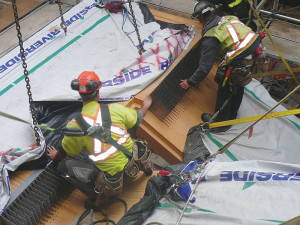
HSK connector at the fully cantilevered atrium stair at UBC Earth Sciences Building. Courtesy of Equilibrium Consulting.
Timber Connection Options
Key to the successful execution of large timber structures is the availability of economical, versatile and reliable connectors. The different timber connection systems available are comparable to individual tools in a toolbox. As an engineer looking for innovative, elegant solutions, one needs a toolbox with a variety of reliable and high-quality tools. Some of these were covered previously in STRUCTURE’s January 2007 article, New Concealed Connectors Bring More Options for Timber Structures; however, several new options have been added in the time since then. The North American toolbox for wood connections is the first of four main compartments: standard through bolts, screws and nails, timber rivets, truss plates and pre-engineered light gauge metal connectors. These are all longstanding inductees of local codes and are well known to most. This does not include North American style split rings and shear plates, which are specified less frequently today.
In compartment number two, we find connection systems that are not explicitly covered by building codes but can be designed within the scope of the codes using first principles. These include castings, shear keys, wood-to-wood notches and steel-to-wood notches.
The third compartment includes generic connection systems, which are not covered in North American codes but are officially recognized in reputable foreign codes such as the Swiss, German or Eurocode. These include tight-fit bolts and pins and ring nails.
The final compartment houses state-of-the-art proprietary systems that are supported by empirical data and usually by foreign (European) codes and approvals. These require careful review and, occasionally, local testing.
The National Design Specification® (NDS®) for Wood Construction 10.1.1.3 states, “Connection design provisions…shall not preclude the use of connections where it is demonstrated by analysis based on generally recognized theory, full-scale or prototype loading tests, studies of model analogues or extensive experience in use that the connections will perform satisfactorily in their intended end uses.” The Canadian standard includes similar provisions.
The proprietary systems the author’s firm engineers have used the BVD or Bertsche system developed by German engineer Peter Bertsche, the SFS WS system by SFS Intech, the HBV and HSK adhesive-based system by TiComTec and developed by Dr. Leander Bathon, the Sherpa or Pitzl aluminum dovetail systems and finally, but not least, the very versatile self-tapping screws.
The following are a number of modern connector types, all of which the author’s firm has used and continue to use. North American connectors are well known to most and will not be discussed in detail here.
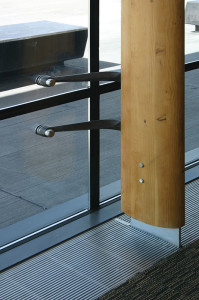
Stainless tight-fit dowels and steel castings at the Prince-George Airport. Courtesy of MacFarlane Green Architecture.
Wood-to-Wood Bearing Connections
The entire family of wood-to-wood bearing connections are an ancient way to transfer shear and compression loads in timber. They used to be done by hand and required skill and time to fabricate. They fell out of favor over the last century, but are making a comeback with the use of CNC equipment. Direct bearing is often the most efficient way to transfer heavy shear and compression loads in wood, and appropriately designed notches, used in combination with self-tapping screws, can be a very cost effective connection solution.
Where notches are required, they should be designed from first principles using the bearing and shear formulas of the code. As a matter of standard practice, ensure that the longitudinal shear portion of a connection, particularly at the end of a member, is proportioned so as not to be the primary failure mode, as it is brittle.
Castings
Castings, usually made of Ductaline steel, are also designed from first principles. They offer an elegant, very versatile way to achieve architecturally important connections, and can be relatively economical in large numbers. Their drawback is that they are susceptible to fire and cannot be used in exposed conditions in a rated assembly.
Tight-Fit Bolts and Pins
Tight-fit bolts are essentially regular bolts installed in bolt holes, both in timber and connecting steel plates, which are drilled to much tighter tolerances. The Eurocode requirement for tight-fit bolts is to have a bolt hole which matches the bolt diameter or is up to 0.5 mm smaller. The bolt hole in the steel must be less than 1.0 mm larger than the bolt diameter. Tight-fit pins, often used for high-end exposed connections, must meet the same requirements, and usually consist of a headless stainless steel shaft with slightly chamfered edges.
The advantage of tight-fit dowels is that the connectors can be relied upon to take the load at essentially the same time, mostly eliminating group effects. A very high degree of accuracy is required, and CNC fabrication is almost always required to achieve a multiple fastener tight-fit connection, particularly with multiple knife plates.
Tight-fit pins are the basis of many proprietary connections, some of which are discussed below.
Ring Nails
Ring nails are Europe’s version of timber rivets. Shiny and having a round head, they look somewhat tidier than timber rivets. The Swiss code provides specific guidelines based on empirical data for achieving ductile connections. One proprietary ring nail connection system is called the Gunnebo nail from Sweden.
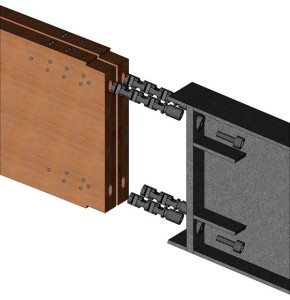
3D model of a BVD moment connection at the Raleigh Durham Airport. Courtesy of Equilibrium Consulting.
The BVD System by Bertsche
The BVD system is a proprietary connector developed and sold by engineer Peter Bertsche of Germany. The system consists of a grooved, drop-forged insert, locked into place by intersecting 16 mm diameter (0.63-inch) tight-fit pins. The cavity is grouted solid with a high-performance cementitious grout to ensure a completely tight-fit load transfer between the dowels and the cast insert. The insert is threaded on the end and can receive a bolt supplied with the insert. Alignment tolerances are dealt with using a spherical washer.
BVDs come in six sizes, normally installed in the shop with 4 (BVD 1) to 24 pins (BVD 6), and can carry a specified pull-out load of 13 to 80 kips (60 to 360 kN) per anchor. The system’s strength and reliability is enhanced by the intersecting dowels, which help contain the wood fiber and resist splitting force. Ultimate loads of 2.5 to 3 times the specified loads are consistently achieved. The system is very efficient for high-tension connections, to carry direct axial loads.
The system is completely tight-fit and therefore can be used in groups without concerns for group effects. It is also concealed by the wood and therefore resistant to fire.
The WS System by SFS Intec
The proprietary WS System by the billion-dollar Swiss fastener company SFS Intec, consists of self-drilling, small diameter dowels equipped with a drill tip designed to core through wood and 3 to 5 mm mild steel internal plates. The pin is driven using a hydraulic press sold by the company.
The advantages of the system are that it requires no pre-drilling, avoids fabrication tolerances and is completely tight-fit. It is ductile, yet very compact due to the small diameter of the pins (5 to 8 mm), and is concealed – making the system fire resistant. The system is quite efficient and versatile, and can be used in shear, axial or moment connections.
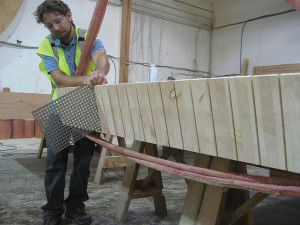
HSK connector being test-fitted for the fully cantilevered atrium stair at UBC Earth Sciences Building. Courtesy of Structurlam Products.
Self-Tapping Screws
Self-tapping screws are the space-age version of the North American lag screw. They are now sold in North America by four major suppliers: SFS, GRK, Wurth and Heco. They are the main connector type now used in solid wood panel construction.
Self-tapping screws are proprietary, self-drilling screws made from high strength (around 115ksi or 800 MPa) steel, and come in a wide variety of sizes from 3/16 to ½-inch (5 mm to 12 mm) in diameter and 3 to 23 inches (8 cm to 60cm) in length. The diameter refers to the diameter of the thread, not the shaft.
There are three major types of self-tapping screws. Fully threaded screws are used to transfer large tension loads in wood-to-wood connections without the need for a washer plate. Partially threaded screws are used to anchor steel bearing plates and can transfer shear as well. They have great clamping capacity. Variable pitch screws are used to pull two pieces of wood together and are often used in solid wood panel edge-to-edge connections to align the panels and transfer longitudinal shear.
Self-tapping screws are extremely versatile, efficient, and reliable, as they require no pre-drilling. They eliminate the risk that an inexperienced carpenter may not drill and counter bore a lag screw hole correctly.
Pre-Engineered Aluminum Dovetail Connections
Aluminum dovetail connectors are pre-engineered aluminum dovetail inserts, normally installed in the shop using self-tapping screws, allowing for timber elements to be very rapidly and accurately erected on site. There are two main suppliers for this type of insert, both represented in North America: Pitzl and Sherpa.
The inserts come in a variety of sizes and capacities. They are recessed and completely concealed by the timber material, making the connection completely invisible and also fire resistant.
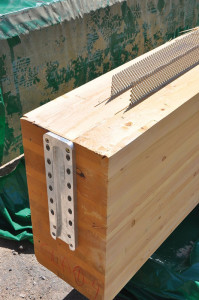
Pre-engineered dovetail connection and HSK wood concrete composite connection at the UBC Earth Sciences Building. Courtesy of Equilibrium Consulting.
The HBV and HSK Connector
The HBV and HSK connectors were both developed by German engineer Leander Bathon. HBV is a connector used to achieve wood-concrete composite floor systems. It consists of an expanded steel mesh glued into a saw cut on the top of the timber beam or solid wood panel using a proprietary adhesive, and cast into the concrete above, rigidly connecting the two together.
The HSK system is similar, but is used to connect steel elements to wood or, occasionally, to connect two wood elements together. It consists of a 2.8 mm (approximately 3/32-inch) perforated steel plate, welded to a steel part in the case of a steel-to-wood connection and glued into a kerf in the timber element, rigidly connecting the two members.
The HSK system is ductile, as the steel parts are usually designed to yield before the adhesive or the wood fails. It can also be completely concealed and therefore resistant to fire.
Growing Market for Timber Applications
The North American timber construction industry has transformed significantly throughout history – and even more rapidly in the past decade alone. At the turn of the 20th century, steel and concrete widely replaced wood in the construction of commercial buildings. A century later, technical advances in fabrication techniques and connection engineering, coupled with a renewed interest in timber as an environmentally friendly building material, have driven renewed interest in the building material. Wood products are being re-examined for new opportunities, in a wider range of building types and reaching greater heights than ever before.▪

